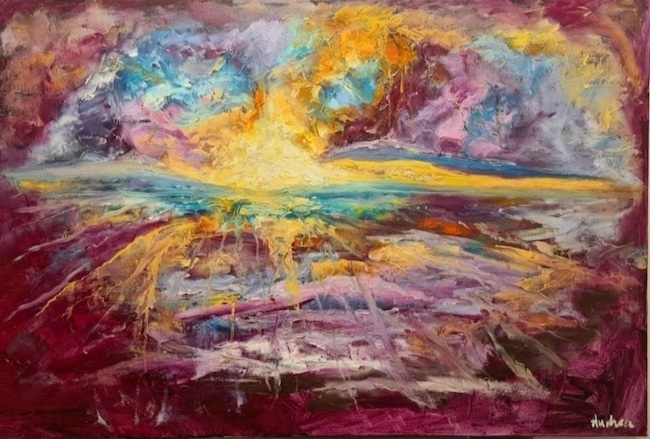Scegliere di muoversi trasversalmente su più linee espressive rappresenta la massima realizzazione di quella libertà a cui tanti artisti contemporanei possono attingere senza il timore di non essere compresi, come invece è accaduto per molti innovatori, liberi pensatori dal punto di vista creativo, del secolo scorso; la necessità di non rinchiudersi all’interno di una gabbia, di uno stile, di una denominazione, diviene prioritaria rispetto al bisogno di avere una chiara linea identificativa, proprio perché all’interno di quell’essere definiti si sentirebbero limitati. L’artista di cui vi parlerò oggi appartiene a questa categoria di artisti.
Quando l’Espressionismo cominciò a imporsi sul mondo dell’arte del Novecento, fu accolto con disgusto e diffidenza in quanto il messaggio che ne fuoriusciva, il lato estetico completamente dimenticato e l’armonia tradizionale assolutamente sovvertita, destabilizzavano la maggior parte dei critici e degli appassionati; tuttavia quella forza espressiva che si impose inizialmente con i Fauves e poi si trasformò e perfezionò con il nuovo movimento opposto all’Impressionismo e al Realismo e di cui furono massimi esponenti grandi artisti europei, da Edvard Munch a Egon Schiele, da Emil Nolde a Oskar Kokoschka, da Paul Gaugin a Vincent Van Gogh, divenne imprescindibile per tutti i maestri che volevano uscire dalle regole accademiche e dare la prevalenza assoluta al sentire interiore, alla soggettività del percepito in grado di trasformare ciò che veniva oggettivamente visto. L’accordo tra colori e forme era dunque funzionale a narrare l’emozione, il sentimento, che dall’artista fuoriusciva e che doveva arrivare, diretto e travolgente, all’osservatore. Seguendo la medesima intenzione esecutiva nacque negli Stati Uniti degli anni Cinquanta, un movimento che volle distaccarsi dalla freddezza e dal rigore dell’Astrattismo Geometrico, del Concettualismo e di tutte le correnti d’avanguardia che escludevano le emozioni spostando il gesto creativo verso la razionalità, verso l’analisi mentale allontanando però in tal modo l’impatto emozionale che deve necessariamente appartenere all’arte; quel rivoluzionario movimento prese il nome di Espressionismo Astratto e confermò le linee guida di base dell’Espressionismo associandolo però alla libertà espressiva dell’Astrattismo. Non solo, Jackson Pollock, Mark Rothko, Willem de Kooning e Franz Kline, ufficialmente i fondatori della nuova corrente, tanto differenti tra loro come stile espressivo da essere orgogliosi di unirsi in virtù di quell’impatto emozionale che, con modalità diverse, contraddistingueva le loro tele, da affermare proprio quanto gli artisti aderenti all’Espressionismo Astratto non dovessero avere delle linee guida e dovessero invece esprimere con naturalezza e senza alcuna regola esecutiva le proprie sensazioni, la loro interiorità. Dunque dal segno all’Action Painting, dal Color Field al Tachisme, dalla figurazione mescolata all’Astratto ai monocromi, tutto era accettato purché funzionale all’artista a lasciare la propria personale impronta sulla tela. Nel mondo contemporaneo i creativi hanno potuto interiorizzare questo nuovo approccio all’arte ampliandolo alla contaminazione con altre correnti del Novecento, mescolando le regole espressive per dar vita a un linguaggio assolutamente personale; oppure hanno potuto scegliere di non soffermarsi su una sola cifra pittorica per poter accordare la narrazione rappresentativa all’emozione del momento, indipendentemente se essa abbia bisogno di una figurazione riconoscibile dall’occhio oppure se debba appartenere all’indefinitezza dell’Astratto.
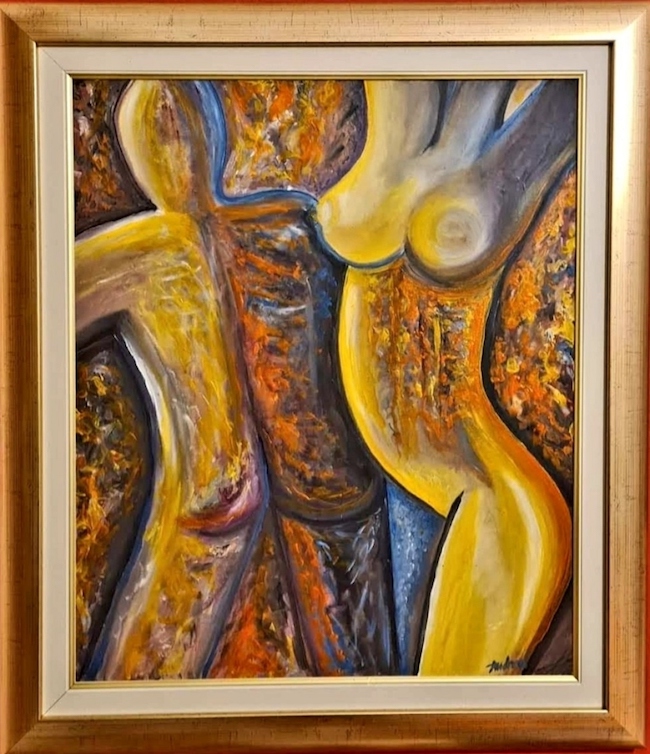
L’artista croata Andrea Stanic sceglie esattamente la via dell’indipendenza espressiva perché per lei l’opera deve avere una sua spiccata personalità, deve essere una prolungazione delle sensazioni che lei ha provato nel momento in cui si è avvicinata alla tela per cominciare a creare; essenzialmente si muove tra Espressionismo Astratto ed Espressionismo a seconda che desideri parlare di un concetto più legato all’interazione, ai rapporti con l’altro, oppure che voglia collegare la natura al sentire interiore, alle profondità dell’essere o alle sensazioni più umane, o ancora che senta l’esigenza di manifestare il suo profondo amore per i paesaggi marini, per le regate, per le vele che spesso colorano il meraviglioso mare del suo paese, la Croazia. La scelta cromatica è sempre vivace, intensa, solare, quasi come se per Andrea Stanic il colore fosse imprescindibile dalla vita, un approccio positivo il suo che non può non fuoriuscire dalle sue tele spesso esplosive ma anche in altri casi più meditative in base all’argomento che sceglie di affrontare.

In Below the surface (Sotto la superficie) l’artista va a esplorare quel mondo interiore che spesso l’essere umano tende a nascondere per non sentirsi vulnerabile, scoperto e dunque facilmente attaccabile, oppure, al contrario, troppo vitale e prorompente per essere accolto favorevolmente all’esterno e dunque il tenere a bada le emozioni diviene funzionale al sentirsi accettati all’interno di una società che fa fatica ad ascoltare le voci fuori dal coro. Ciò che si trova sotto il velo è però travolgente, entusiasmante, ed esiste malgrado le maschere che l’individuo crede di dover indossare.
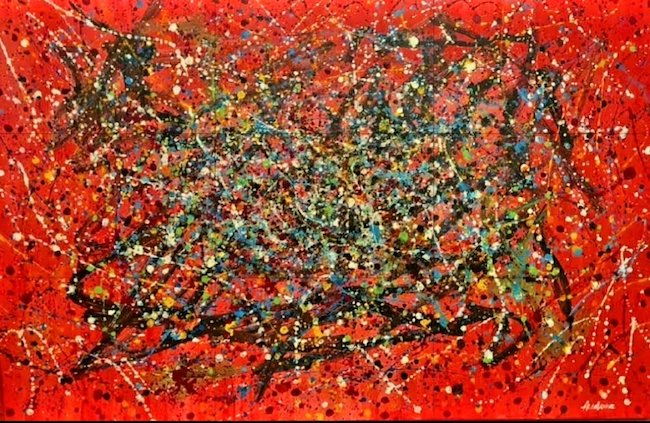
In The birth feeling (Il sentimento della nascita) invece passa all’Action Painting, perché l’impulsività di quelle sensazioni di cui narra il titolo sono incontenibili, divengono prioritarie rispetto a tutto ciò che in precedenza è stato vissuto e percepito; l’opera può essere interpretata da un duplice punto di vista, quello della gioia della maternità in cui tutte le prospettive si modificano davanti a un bene immenso in grado di investire la vita di nuova linfa, di insospettata felicità, oppure da quello personale laddove la nascita è più una rinascita, un cambiamento radicale nell’affrontare se stessi e la propria vita grazie al quale ogni cosa assume un significato nuovo, più bello, più entusiasmante in virtù della nuova consapevolezza di sé.
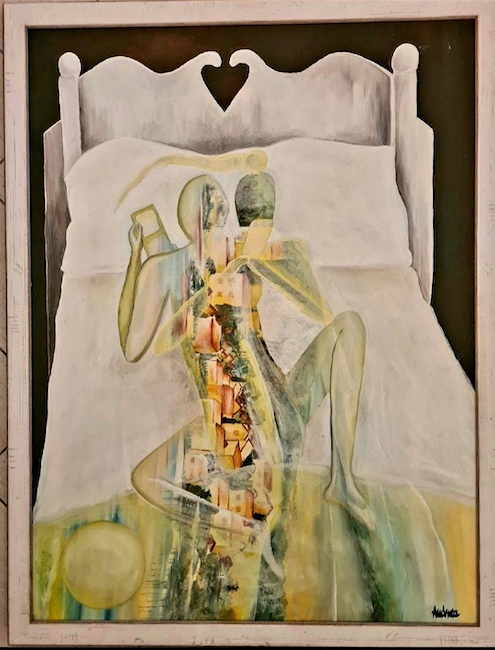
Ma Andrea Stanic esplora anche il mondo più reale, quello strano vivere contemporaneo in cui tutti i rapporti sono cambiati rispetto al secolo precedente, in cui il contatto tra le persone è limitato dall’avanzare della tecnologia impedendo agli esseri umani di riuscire a guardarsi negli occhi anche quando sono insieme; è questo il concetto che emerge dalla tela Modern love, dove l’artista si orienta alla figurazione espressionista per descrivere i due innamorati in qualche modo uniti ma al tempo stesso divisi dai propri cellulari, come se fossero insieme ma altrove e dunque distanti malgrado l’apparente vicinanza. Il letto è il luogo in cui sono ritratti eppure sono lì in trasparenza perché sui loro corpi appaiono paesaggi lontani, esterni, come se ciascuno di loro volesse in realtà trovarsi altrove, salvo poi desiderare comunque di restare insieme, dando vita a una contraddizione esistenziale in cui molte coppie moderne vivono il loro rapporto.
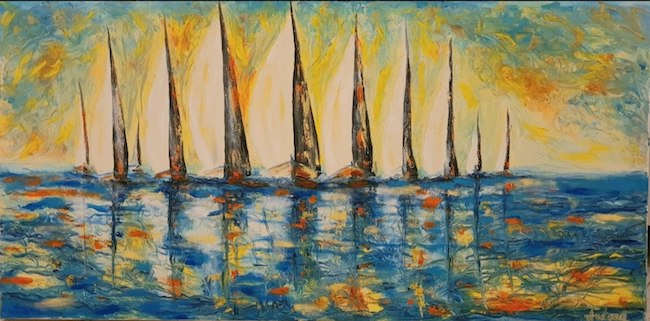
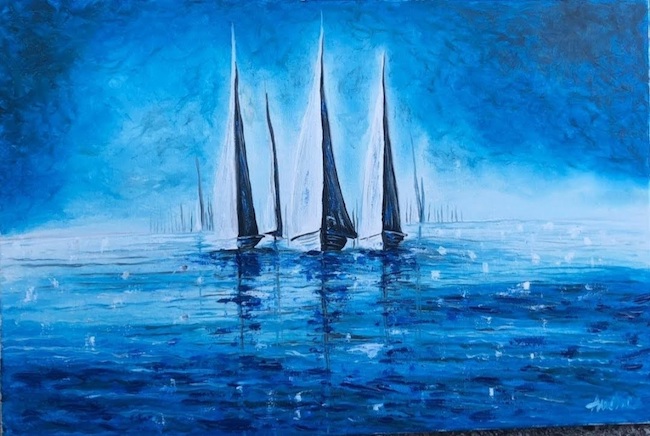
Ma nella produzione della Stanic non potevano mancare le vele e il suo amato mare, quel paesaggio che ha davanti allo sguardo da sempre e che la trasporta verso emozioni e sensazioni morbide, avvolgenti, lontane eppure familiari proprio in virtù del fatto di averle guardate da sempre; il tratto nelle tele Fiumanka21 e Regata20 è espressionista ma al tempo stesso strizza l’occhio ai paesaggi impressionisti di Monet soprattutto nei riflessi dell’acqua, nella capacità di catturare l’atmosfera romantica che parte dal sentire interiore e raggiunge la tela attraverso il tocco pittorico.
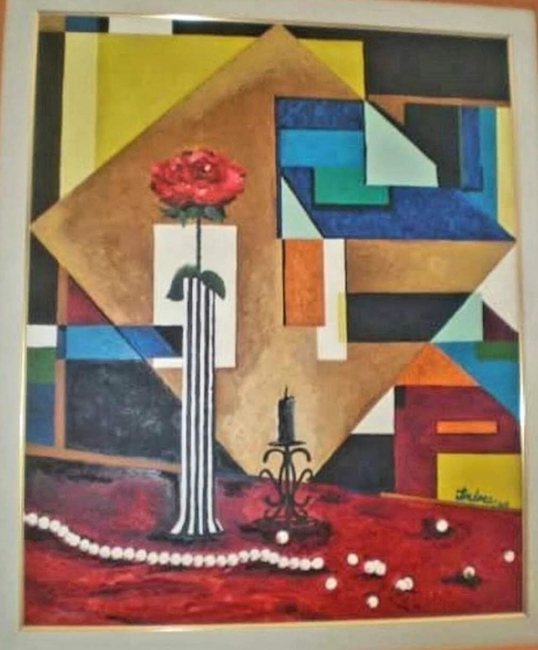
La leggerezza viene raccontata con le tonalità sfumate, soffuse, come se all’interno di quel paesaggio definito si nascondesse l’indefinito delle emozioni che si liberano osservando i profili delle vele, le lievi onde del mare. Questo è il percorso artistico di Andrea Stanic, un trasversale esplorare e fare proprie le varie tecniche pittoriche sulla base di ciò che desidera esprimere, come se non fosse lei a decidere quale stile utilizzare bensì fosse l’istinto creativo a suggerirle quale cifra stilistica scegliere, come se l’opera prendesse forma in maniera autonoma, attraverso una sua spiccata personalità. Andrea Stanic ha all’attivo molte mostre personali in Croazia e la partecipazione a molte mostre collettive nel suo paese e all’estero, India, Guatemala, Egitto, Sri Lanka, Australia, Italia, durante le quali ha avuto modo di ricevere numerosi riconoscimenti.
ANDREA STANIC-CONTATTI
Email: andrea.stanic.ri@gmail.com
Sito web: https://andreas-artgallery.eu/hr/
Facebook: https://www.facebook.com/ArtGalleryAndreaS/
https://www.facebook.com/andrea.stanic.ri
Instagram: https://www.instagram.com/andys_007/
Andrea Stanic’s stylistic freedom, to emphasise the unique message of each artwork
Choosing to move transversally along a number of expressive lines represents the maximum realisation of that freedom which many contemporary artists can draw on without fear of not being understood, as happened for many innovators, free thinkers from a creative point of view, in the last century; the need not to enclose oneself within a cage, a style, a denomination, becomes primary than need to have a clear identifying line, precisely because within that being defined one would feel limited. The artist I am going to talk about today belongs to this category of artists.
When Expressionism began to impose itself on the twentieth-century art world, it was greeted with disgust and mistrust because the message that came out of it, the aesthetic side that was completely forgotten and the traditional harmony that had been absolutely subverted, destabilised most critics and enthusiasts; however, that expressive force that first imposed itself with the Fauves and then transformed and perfected itself with the new movement opposed to Impressionism and Realism and of which great European artists were great exponents, from Edvard Munch to Egon Schiele, from Emil Nolde to Oskar Kokoschka, from Paul Gaugin to Vincent Van Gogh, became essential for all masters who wanted to break away from academic rules and give absolute prevalence to inner feeling, to the subjectivity of perception capable of transforming what was objectively seen. The agreement between colours and forms was therefore functional to narrate the emotion, the feeling that came out of the artist and that had to reach the observer directly and overwhelmingly.
Following the same executive intention, a movement was born in the United States in the 1950s that wanted to break away from the coldness and rigour of Geometric Abstractionism, Conceptualism and all the avant-garde currents that excluded the emotions, moving the creative gesture towards rationality, towards mental analysis, thus removing the emotional impact that must necessarily belong to art; this revolutionary movement took the name of Abstract Expressionism and confirmed the basic guidelines of Expressionism, but associated it with the expressive freedom of Abstractionism. Not only that, Jackson Pollock, Mark Rothko, Willem de Kooning and Franz Kline, officially the founders of the new current, so different from each other in their expressive style that they were proud to unite in virtue of the emotional impact that, in different ways, distinguished their canvases, to affirm just how much the artists adhering to Abstract Expressionism should not have guidelines and should instead express naturally and without any executive rules their own sensations, their interiority. So from sign to Action Painting, from Colour Field to Tachisme, from figuration mixed with Abstract to monochrome, everything was accepted as long as it was functional for the artist to leave his personal mark on the canvas. In the contemporary world, creatives have been able to internalise this new approach to art, broadening it to include contamination with other twentieth-century currents, mixing the rules of expression to give life to a totally personal language; or they have been able to choose not to dwell on a single pictorial code in order to be able to tune the representative narrative to the emotion of the moment, regardless of whether it needs a figuration that is recognisable to the eye or whether it should belong to the indefiniteness of the Abstract.
Croatian artist Andrea Stanic chooses precisely the path of expressive independence because for her, the work must have its own distinct personality, it must be an extension of the feelings she experienced when she approached the canvas to begin creating; basically, she moves between Abstract Expressionism and Expressionism, depending on whether she desires to talk about a concept more linked to interaction, to relationships with others, or whether she wants to link nature to her inner feelings, to the depths of her being or to more human sensations, or whether she feels the need to express her deep love for seascapes, for regattas, for the sails that often colour the wonderful sea of her country, Croatia. The choice of colour is always lively, intense, sunny, almost as if for Andrea Stanic colour was inseparable from life, a positive approach that cannot fail to emerge from her paintings, which are often explosive but also in other cases more meditative, depending on the subject she chooses to deal with. In Below the surface the artist explores that inner world that human beings often tend to hide in order not to feel vulnerable, uncovered and therefore easily attacked, or, on the contrary, too vital and bursting to be welcomed outside and so keeping emotions at bay becomes functional to feel accepted in a society that finds it difficult to listen to voices that are not in tune with the choir. What lies beneath the veil, however, is overwhelming, exciting, and exists in spite of the masks the individual believes he or she must wear. In The birth feelings, however, she switches to Action Painting, because the impulsiveness of those feelings of which the title speaks are irrepressible, they become priority over everything that has previously been experienced and perceived; the painting can be interpreted from a twofold point of view, that of the joy of motherhood in which all perspectives are modified in the face of an immense love capable of investing life with new lifeblood, with unsuspected happiness, or from a personal point of view where birth is more a rebirth, a radical change in facing oneself and one’s life thanks to which everything takes on a new, more beautiful, more exciting meaning by virtue of the new self-awareness.
But Andrea Stanic also explores the more real world, that strange contemporary life in which all relationships have changed compared to the previous century, in which contact between people is limited by the advance of technology, preventing humans from being able to look each other in the eye even when they are together. This is the concept that emerges from the canvas Modern Love, in which the artist turns to expressionist figuration to describe two lovers who are somehow united but at the same time separated by their mobile phones, as if they were together but elsewhere and therefore distant despite their apparent closeness. The bed is the place where they are portrayed and yet they are there in transparency because distant, external landscapes appear on their bodies, as if each of them actually wanted to be somewhere else, except that they nevertheless wish to remain together, giving rise to an existential contradiction in which many modern couples live their relationship. But Stanic’s production could not fail to include sails and her beloved sea, that landscape that she has always had in front of her eyes and that transports her towards soft, enveloping emotions and sensations, distant yet familiar precisely because she has always looked at them; the stroke in the canvases Fiumanka21 and Regata20 is expressionist but at the same time winks at Monet’s impressionist landscapes, especially in the reflections of the water, in the ability to capture the romantic atmosphere that starts from the inner feeling and reaches the canvas through the pictorial touch. The lightness is told with the nuanced, suffused tones, as if within that defined landscape is hidden the indefinite of emotions that are released by observing the profiles of the sails, the gentle waves of the sea. This is Andrea Stanic’s artistic path, a transversal exploration and making one’s own the various pictorial techniques on the basis of what she wishes to express, as if it were not she who decided which style to use but rather it was her creative instinct that suggested which stylistic figure to choose, as if the artwork took shape autonomously, through a distinct personality. Andrea Stanic has had many solo exhibitions in Croatia and participated in many group exhibitions in her country and abroad, India, Guatemala, Egypt, Sri Lanka, Australia, Italy, during which she has received numerous awards.


